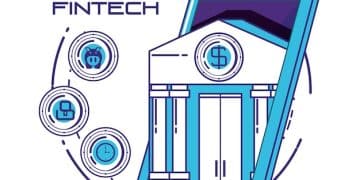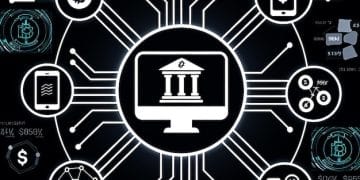How Fintech Bridges the Gap: Financial Inclusion in US Communities

How are Fintech Companies Addressing Financial Inclusion Challenges in Underserved US Communities? By leveraging technology, fintech firms are creating innovative solutions to provide financial services to those traditionally excluded from the banking system, offering tools for savings, credit, and financial literacy.
In the United States, many communities face significant barriers to accessing traditional financial services. How are Fintech Companies Addressing Financial Inclusion Challenges in Underserved US Communities? They are stepping up by using technology to break down these barriers, offering innovative solutions that cater to the specific needs of these populations. This article explores how fintech is fostering financial inclusion, creating opportunities for economic empowerment.
Understanding Financial Inclusion Challenges in the US
Financial inclusion refers to ensuring that all individuals and businesses, regardless of their socioeconomic status, have access to and can effectively use a range of financial services. These services include not only basic banking but also credit, insurance, and investment opportunities. However, in the US, numerous underserved communities face substantial obstacles in achieving financial inclusion.
Barriers to Financial Inclusion
Several factors contribute to the financial exclusion of certain communities in the US. One significant challenge is the lack of access to traditional banking infrastructure, particularly in rural areas and low-income urban neighborhoods. Many individuals also lack the necessary financial literacy to manage their finances effectively or navigate complex financial products.
- Lack of banking infrastructure: Limited physical bank branches in underserved areas make it difficult for residents to open accounts and conduct transactions.
- Financial illiteracy: A lack of understanding of basic financial concepts hinders effective money management and decision-making.
- High costs: Fees associated with traditional banking services can be prohibitive for low-income individuals.
- Lack of credit history: Many individuals lack a credit history, making it challenging to access credit and loans.
The absence of these crucial elements perpetuates income inequality and limits economic mobility, making it essential to find creative solutions to tackle these issues head-on.
In conclusion, by understanding the obstacles to financial inclusion, the impact of fintech solutions can be better understood, revealing advancements and future developments.

The Rise of Fintech and Its Potential for Financial Inclusion
Fintech, or financial technology, has emerged as a powerful tool for addressing financial inclusion challenges. Fintech companies leverage technology to offer innovative financial services that are often more accessible, affordable, and user-friendly than traditional banking options.
Advantages of Fintech Solutions
Fintech solutions offer a range of advantages that make them particularly well-suited for addressing financial inclusion challenges. Mobile banking apps, for example, provide convenient access to financial services for individuals who may not have easy access to physical bank branches. Additionally, fintech companies often use alternative credit scoring methods, such as analyzing utility bill payments or social media activity, to assess creditworthiness. These methods can help individuals with limited or no credit history to access credit and loans.
- Accessibility: Mobile banking apps and online platforms provide access to financial services 24/7, regardless of location.
- Affordability: Fintech companies often offer lower fees and interest rates than traditional banks.
- User-friendliness: Fintech solutions are typically designed to be easy to use, even for individuals with limited financial literacy.
- Alternative credit scoring: Fintech companies use innovative methods to assess creditworthiness, expanding access to credit for those with limited credit history.
Using these techniques allows fintech companies to reach demographics that have previously been underserved, enabling them to enter the financial sector and improve their lives.
To summarize, fintech is redefining financial inclusiveness via technology to offer new levels of accessibility, efficiency, and inclusion that are superior to those previously attained.
How are Fintech Companies Addressing Financial Inclusion Challenges in Underserved US Communities?
How are Fintech Companies Addressing Financial Inclusion Challenges in Underserved US Communities? Fintech companies are rising to the occasion with innovative and targeted solutions. These companies are disrupting the traditional financial landscape by focusing on accessibility, affordability, and user-friendliness, thus helping meet the specific needs of underserved communities.
Specific Fintech Initiatives
Several fintech initiatives are specifically designed to address financial inclusion challenges in underserved US communities. For example, some companies offer microloans to small businesses and entrepreneurs who may not qualify for traditional bank loans. Others provide financial literacy programs to help individuals improve their money management skills. Mobile banking platforms that focus on cost-free minimal balance options make it easier to save and transact without incurring additional costs.
- Microloans: Providing small loans to entrepreneurs and small businesses.
- Financial literacy programs: Offering education and resources for better money management.
- Mobile banking: Delivering convenient and low-cost banking services.
- Alternative credit scoring: Expanding access to credit by using non-traditional data.
This commitment to equality is enabling people attain financial stability and independence and has an influence on their personal lives as well as their communities.
The conclusion is that fintech businesses are playing a critical role in advancing financial inclusion by utilizing customized and practical solutions and offering possibilities via the power of technology.

Case Studies: Fintech Success Stories in Underserved Communities
To illustrate the impact of fintech on financial inclusion, it is helpful to examine specific case studies of fintech companies that have successfully served underserved communities in the US.
Examples of Impactful Fintech Companies
One example is a fintech company that partners with local community organizations to offer financial coaching and access to affordable financial products. By working directly with community members, the company can build trust and tailor its services to meet the specific needs of the community. Another company offers a mobile banking app specifically designed for unbanked individuals, providing a user-friendly platform for managing their finances.
- Partnerships with community organizations: Building trust and tailoring services.
- Mobile banking for the unbanked: Providing user-friendly financial management platforms.
- Affordable financial products: Offering low-cost alternatives to traditional banking.
- Personalized financial coaching: Empowering individuals to make informed financial decisions.
These case studies prove that fintech has a significant influence in transforming people’s life, boosting economic development, and building community resilience.
However, more progress is needed to realize fintech’s potential and remove impediments to economic growth.
Challenges and Opportunities for Fintech in Financial Inclusion
While fintech holds enormous promise for promoting financial inclusion, several challenges and opportunities must be addressed to maximize its impact. One challenge is the need to ensure that fintech solutions are accessible and affordable for all individuals, regardless of their income level or technological proficiency.
Navigating the Future of Fintech and Financial Inclusion
Although some barriers to entrance remain, creativity and strategic approaches can help fintech enterprises successfully negotiate these difficulties. Building trust with customers in underserved areas, guaranteeing data security, and taking into account possible regulatory obstacles are also essential to encourage ethical and responsible innovation.
- Ensuring accessibility: Designing solutions that are user-friendly for individuals with varying levels of technological proficiency.
- Maintaining affordability: Offering low-cost or free services to low-income individuals.
- Addressing regulatory challenges: Working with regulators to create a supportive environment for fintech innovation.
- Building trust: Establishing strong relationships with community members and organizations to build trust in fintech solutions.
Fintech businesses may play an important role in bridging the financial inclusion gap and supporting disadvantaged communities by overcoming the above obstacles and seizing possibilities.
The conclusion: Fintech holds the key to inclusive solutions, but addressing issues and taking use of chances is crucial for optimum impact.
The Future of Fintech and Financial Inclusion in the US
The future of fintech and financial inclusion in the US looks promising, with ongoing technological advancements and a growing recognition of the importance of financial inclusion. As technology continues to evolve, fintech companies will have even more tools at their disposal to address the specific needs of underserved communities.
Emerging Trends and Predictions
Looking ahead, several trends are expected to shape the future of fintech and financial inclusion. Artificial intelligence (AI) and machine learning (ML) could potentially provide more tailored financial advice. Blockchain technology can enable more secure and transparent transactions. Moreover, it is vital for fintech firms to be aware of emerging trends in order to anticipate future difficulties and successfully negotiate the changing environment.
- Artificial intelligence: Using AI to provide personalized financial advice and support.
- Blockchain technology: Leveraging blockchain for secure and transparent transactions..
- Data analytics: Harnessing data to better understand the needs of underserved communities.
- Collaborative partnerships: Forming partnerships with community organizations and government agencies to expand reach and impact.
Fintech will become an effective instrument for establishing financial inclusion and enabling underserved groups if these developments are embraced and leveraged appropriately. Furthermore, this improves economic results across the United States.
In brief, the future of fintech and financial inclusion will be characterized by progress, innovation, and collaboration that will have a better, more inclusive effect for everybody.
| Key Point | Brief Description |
|---|---|
| 💡 Fintech Solutions | Innovative financial services that are more accessible and affordable. |
| 📱 Mobile Banking | Provides 24/7 access to financial services regardless of location. |
| 📚 Financial Literacy | Programs to improve money management skills in underserved communities. |
| 🤝 Community Partnerships | Collaborations to build trust and tailor financial services to specific community needs. |
Frequently Asked Questions
Fintech companies are enhancing financial inclusion by providing user-friendly digital platforms, lowering fees, and utilizing alternative credit scoring methods to reach underserved populations.
Common barriers include the lack of access to traditional banking infrastructure, high banking fees, financial illiteracy, and the absence of a credit history, particularly in low-income communities.
Mobile banking apps offer 24/7 access to financial services, allowing users to manage their money, pay bills, and transfer funds from anywhere, making them extremely convenient for those without easy access to traditional banks.
Alternative credit scoring involves using non-traditional data such as utility bill payments, rent payments, and social media activity to assess creditworthiness, helping individuals with limited credit history gain access to loans and credit.
Collaborations between fintech companies and community organizations build trust, tailor services to meet specific community needs, and expand the reach of financial inclusion initiatives, ensuring more effective and sustainable outcomes.
Conclusion
In conclusion, how are Fintech Companies Addressing Financial Inclusion Challenges in Underserved US Communities? By leveraging technological advancements, fintech firms offer accessible, affordable, and user-friendly innovative solutions aimed at promoting financial inclusion, which is crucial for the economic empowerment of underserved communities. As fintech continues to evolve, its potential to level the financial playing field and create opportunities for all becomes ever more promising.





